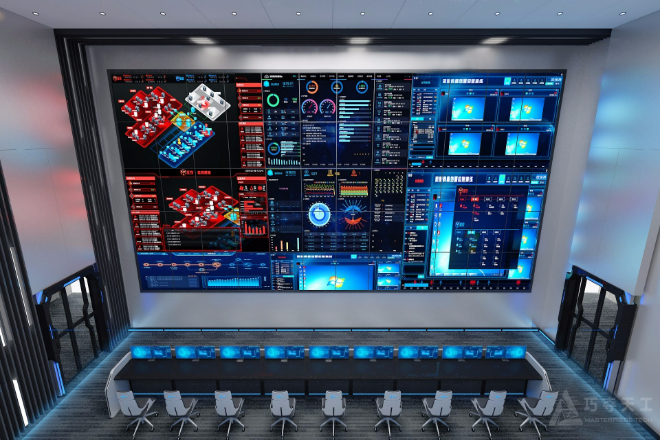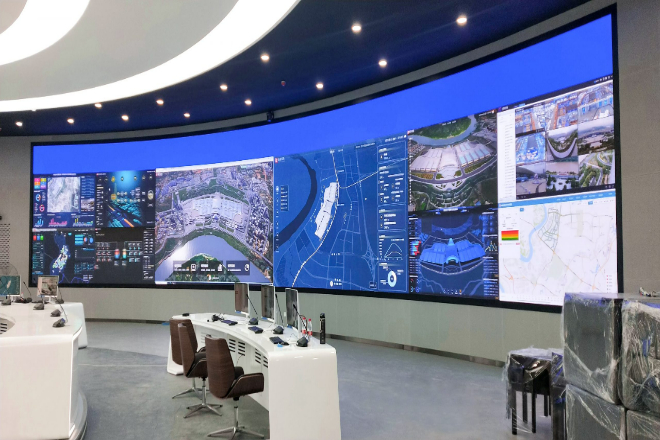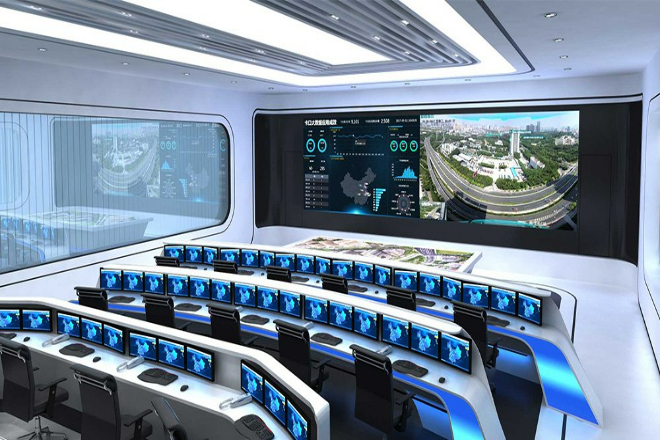Introduction
In today’s society, emergencies occur frequently. As the core organization for responding to various emergencies, the operating efficiency of the emergency command centre is directly related to the speed and effect of emergency response.
As an important information display platform of the emergency command centre, the LED display system undertakes the important task of transmitting key information and supporting decision-making.
In an emergency, every second is crucial. Therefore, achieving the critical second-level response of the LED display system is of vital significance to improving the efficiency and accuracy of emergency commands.
1. The demand background of the second-level response of the LED display system

1). Timeliness of emergency command
In the handling of emergencies, time is life, and the timeliness and accuracy of information transmission are directly related to the efficiency and effect of decision-making. Imagine that when a sudden fire or earthquake occurs, every second of delay may lead to more losses.
As the “brain” for responding to these emergencies, the emergency command centre needs to quickly summarize and analyze information from all parties and make quick and accurate decisions.
Therefore, for the LED display system, being able to display key information in real-time and accurately is crucial to improving the speed of emergency response and decision-making efficiency.
2). Second-level display of key information
In emergency command scenarios, the LED display system is like a pair of “eyes” that allow commanders to see the real-time situation on the scene for the first time.
In order to achieve the second-level display of key information, the LED display system needs to have an extremely high refresh rate and response speed.
This means that when the situation on the scene changes, such as the spread of fire at the fire scene and the collapse of houses in earthquake-stricken areas, the LED display can update the display content almost instantly, allowing commanders to quickly grasp the latest situation and make faster and more accurate decisions.
3). Technical challenges and solutions
To achieve a second-level response, the LED display system faces many technical challenges. For example, there may be delays in the data transmission process, the display refresh rate may be limited, and the system may have stability problems after long-term operation.
In order to overcome these challenges, we can adopt some practical solutions. For example, optimize the data transmission path, use a higher-speed network interface and a dedicated data transmission protocol to reduce the “traffic jam” phenomenon of data transmission, improve the display refresh rate, and make the display “refresh” faster by improving the LED driver chip and display control technology。
Enhance system stability, adopt redundant design and fault self-detection mechanism to ensure that the system can remain stable even under high load and long-term operation.
2. High-speed signal transmission and processing of LED display screens
1). Multiple signal source access
In emergency command, we need to obtain information from various channels, such as real-time video from surveillance cameras, remote images from video conferencing systems, and high-definition images sent back by drones.
The LED display system is like an “information distribution center” and needs to support the access of multiple signal sources. By integrating multiple signal interfaces such as HDMI, DVI, SDI, and network interfaces, the LED display screen can flexibly access signals from different sources to meet the diverse information display needs in emergency commands.
2). High-speed signal transmission
Imagine that if the signal transmission process is in “slow motion”, the efficiency of emergency command will definitely be greatly reduced.
In order to ensure the real-time and stability of signal transmission, the LED display system needs to adopt a high-speed and stable network connection, such as Gigabit Ethernet or fibre optic transmission.
At the same time, advanced signal processing technology is also needed to compress and decompress the video, correct errors, enhance the signal, and ensure that the signal is not distorted or delayed during transmission, just like watching a high-definition movie.
3). Intelligent signal recognition and switching
In emergency command, we may need to switch different signal sources at any time, such as switching from surveillance cameras to images sent back by drones. This requires the LED display system to recognize and switch signals intelligently.
Intelligent signal recognition technology can automatically identify the type and quality of the accessed signal and quickly access and stably transmit the signal according to preset rules or user instructions.
The built-in signal switcher is like a “traffic commander”, which can achieve seamless switching between different signal sources to ensure smooth and uninterrupted images during emergency commands.
3. Principle of nanosecond display technology of LED display

Nanosecond display technology, does it sound very high? In fact, its principle is not complicated. Simply put, the LED display can complete the on-off switching of pixels in a very short time (nanosecond level), thereby achieving extremely high refresh rate and response speed.
This technology greatly shortens the switching time of pixels by optimizing the control logic and circuit design of the LED driver chip, just as fast as the speed of our blinking, or even faster!
The application effect of nanosecond display technology in the emergency command centre is very significant.
It can achieve high-definition, high-brightness, and realistic color display, and keep the picture clear and smooth even in rapidly changing scenes.
For example, when tracking the spread of a fire, nanosecond display technology can ensure that the picture is not smeared or blurred, allowing commanders to accurately judge the direction and speed of the spread of the fire, so as to make faster and more accurate decisions.
It is not an easy task to achieve nanosecond display technology. We need to optimize and innovate key components such as LED driver chips and control systems. For example, the design of the driver chip can be improved, and more advanced semiconductor processes and circuit designs can be used to improve the processing speed and response capability of the driver chip.
The architecture of the control system can be optimized, and distributed control or parallel processing technology can be used to improve the processing efficiency and stability of the control system.
High-speed interface technology, such as LVDS (low voltage differential signal), can also be used to reduce delays and interference during signal transmission. Through the implementation of these measures, we can enable LED display screens to achieve nanosecond display technology and provide more efficient and reliable support for emergency commands.
4. Efficient data processing and analysis of LED display screens
1). Data collection and integration
In emergency command, the timeliness and accuracy of data are crucial. The LED display system plays an important role in data aggregation and display.
It can collect information from different data sources, including sensor data, surveillance video streams, social media information, meteorological data, etc., through a variety of interfaces and protocols, such as API, database connection, network packet capture, etc.
After the data is collected, it will go through an efficient integration process through data cleaning, deduplication, formatting and other steps to ensure the accuracy and consistency of the data.
The integrated data provides comprehensive and accurate data support for emergency command, enabling commanders to quickly grasp the situation on the scene and make more accurate decisions.
2). Real-time data analysis
If the collected data is simply displayed, its value will be greatly reduced. The LED display system combines big data analysis technology to analyze the collected data in real-time.
Through the algorithm model, the system can explore the potential flaws in the data and predict the development trend of the situation, such as the spread direction of the fire and the rise and fall of the flood.
These analysis results will be displayed in real-time on the LED display in the form of charts, animations, etc., providing intuitive and powerful data support for decision-making.
3). Decision-making support tools
In order to further improve the efficiency and accuracy of emergency commands, the LED display system also integrates a variety of decision-making support tools. For example, GIS (Geographic Information System) technology can combine on-site conditions with geospatial information to provide commanders with intuitive geographic references.
Predictive models can predict and simulate future situations based on historical data and real-time data. The combined use of these tools enables commanders to make decisions more quickly and accurately, and effectively respond to various emergencies.
5. LED display system stability and reliability

1). Hardware stability
The hardware stability of the LED display system is the basis for its long-term and reliable operation. The system uses high-quality hardware materials, such as high-brightness LED lamp beads, stable drive circuits, and solid mechanical structures to ensure the durability and reliability of the equipment.
At the same time, the advanced heat dissipation design also effectively prevents the problem of equipment damage due to overheating. This hardware guarantees that the LED display system will operate stably in various harsh environments and provide continuous support for emergency command.
2). Software reliability
In addition to hardware stability, software reliability is also an indispensable part of the LED display system. The system software adopts a stable architecture and design to ensure the stability and reliability of the system.
The online diagnostic function can monitor the system’s operating status in real-time, and discover and solve problems in a timely manner; the upgrade and replacement function enables the system to be continuously updated and improved as technology develops.
In addition, the friendly Chinese interface and centralized control function also make the system operate more easily and efficiently.
3). Redundant design
In order to ensure normal operation under extreme conditions, the LED display system adopts a redundant design.
For example, the N+1 power supply system can quickly switch to the backup power supply when the main power fails to ensure the continuous operation of the system; the dual-channel signal input can automatically switch to the other signal when one signal fails to ensure the continuous transmission of information.
These redundant designs enable the LED display system to maintain stable operation in the face of various emergencies and provide reliable support for emergency command.
Conclusion
To achieve the second-level response of the LED display system, advanced hardware equipment and software technology are required, as well as the overall design and optimization of the system.
Through high-speed signal transmission and processing, nanosecond display technology, efficient data processing and analysis, and system stability and reliability, we can ensure that the LED display system plays the greatest role in emergency command.
Finally, if you want to know more about LED displays, please get in touch with us.
